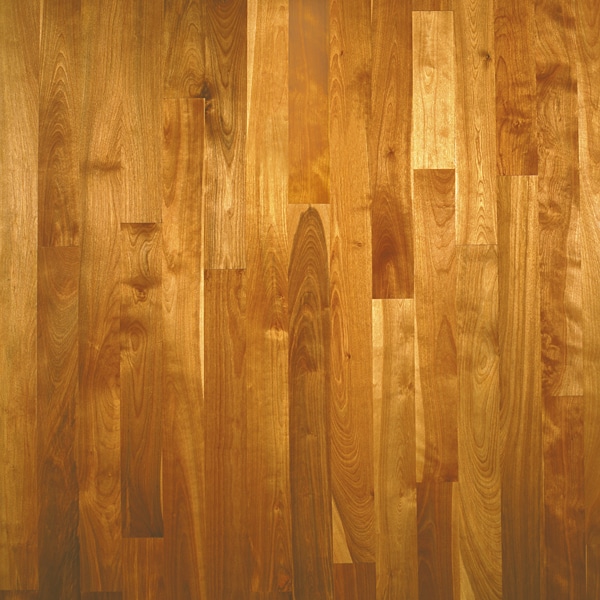
Quick Specs
Common Name(s): Red Birch
Scientific Name: Betula alleghaniensis
Distribution: Northeastern North America
Tree Size: 65-100 ft (20-30 m) tall, 2-3 ft (.6-1.0 m) trunk diameter
Average Dried Weight: 43 lbs/ft3 (690 kg/m3)
Specific Gravity (Basic, 12% MC): .55, .69
Janka Hardness: 1,260 lbf (5,610 N)
Modulus of Rupture: 16,600 lbf/in2 (114.5 MPa)
Elastic Modulus: 2,010,000 lbf/in2 (13.86 GPa)
Crushing Strength: 8,170 lbf/in2 (56.3 MPa)
Shrinkage: Radial: 7.3%, Tangential: 9.5%, Volumetric: 16.8%, T/R Ratio: 1.3
Red Birch Solid Wood Flooring Grades
NWFA-NOFMA SELECT & BETTER RED BIRCH: Shall have the face practically free of all defects,
but the natural color of the wood shall not be considered a defect. The highest standard grade, combines appearance and durability.
Will admit the following: variations in the natural color of the wood (with use of some finishes, slight shadows and
color variation may appear); an occasional small, firm pin knot, not over 1/8″ (.125”) (3.18 mm) in diameter,
provided it does not occur on edges or ends of the piece; occasional dark green or black spots or streaks not over
1/4″ (.250”) (6.35 mm) wide and 3″ (76.2 mm) long (or its equivalent) which may contain a tight check not over 1/2″ (.500”) (12.7 mm) long, provided it is boxed within the piece; bird’s eyes and small burls; slightly torn grain; or similar defect which can be readily removed by the ordinary method of sanding the floor after it is laid; a slightly shallow place not over 12″ (304.8 mm) long on the underside of the flooring if it does not extend to either end of the piece. Pieces with one-half (1/2) tongue for no more than 25% of the length are allowed. The wood must be sound and free of shake. Bark streaks shall not be permitted.
NWFA-NOFMA NO. 1 COMMON RED BIRCH: A floor with varying wood characteristics and colors to include distinct color variations, numerous streaks, stained sapwood, sound knots, and checks. All defects must readily fill.
Will admit the following: sound tight knots, provided they do not occur on edges or ends of pieces; slight
imperfections in machining; distinct color variations; sticker stain/shadow; numerous dark green or black spots or
streaks, provided they do not occur in combination with predominantly dark heartwood; slight checks not exceeding 3″ (76.2 mm) in length (may be slightly open) and running parallel with and well inside the edges and ends of the pieces; dark spots or streaks with slight checks in center; small rough spots (torn grain) which cannot be wholly removed by ordinary method of sanding the floor after it is laid; slightly torn edges; short tongue if sufficient to hold properly in the floor; shallow or waney back, if piece has sufficient bearing of full thickness to support it in the floor; small bark streaks where bark is as sound as surrounding wood; and slight variation in angle of end matching. The face shall be free of shake and wood must be sound.
NWFA-NOFMA NO. 2 COMMON RED BIRCH: Must be of such character as will lay and give a good serviceable floor. The wood must be firm, serviceable and may contain all defects common to Maple.
Will not admit: Knot holes over 3/8″ (.375”) (9.53 mm) in diameter or unsound knots where the unsound portion is
over 1″ (25.4 mm) in diameter; voids on ends or edges; or shake, heart checks, badly split ends and imperfections in manufacture which would materially impair the serviceability of the floor. Occasional scant thickness (hit or miss) on the back of the flooring board the entire length of the piece admitted, providing there is full bearing across the board at some point within three inches of the ends. A limited number of pieces with no tongue admitted.
